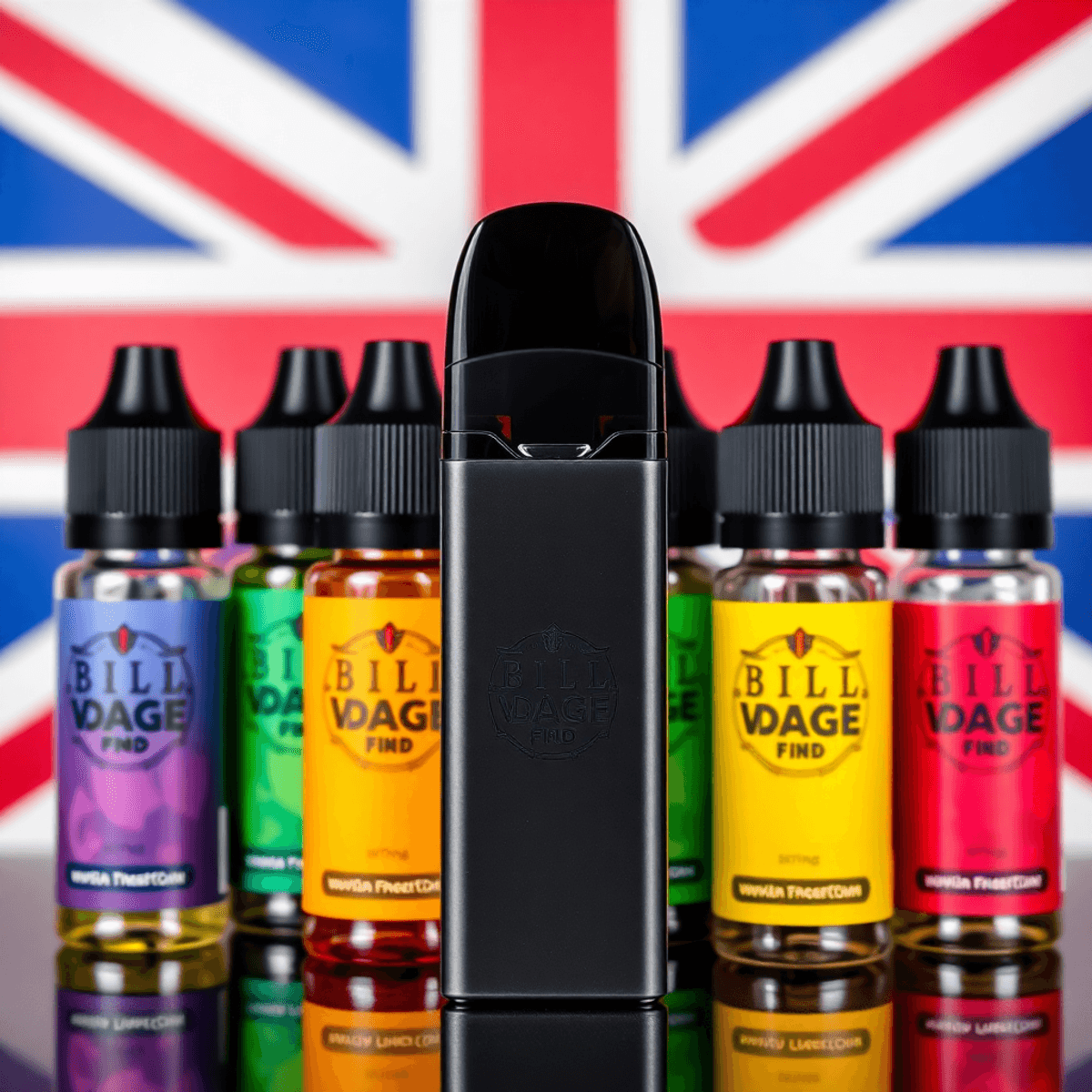Vaping has changed the way people quit smoking, with millions of individuals in the UK turning to e-cigarettes instead of traditional tobacco products. As vaping becomes more popular, it’s important to understand how it affects our senses.
At Team Top Vapes, our expert reviewers based in Manchester have spent countless hours testing hundreds of vaping products, from the compact Vaporesso Eco Nano 16W Pod Vape Kit to high-tech options like the Vaporesso XROS Series Corex 2.0 Replacement Pods. Through thorough testing and analysis of user feedback, we’ve gained valuable insights into how vaping affects taste and smell perception.
One question we often get from our community is: “Will vaping impact my ability to taste and smell?” The answer isn’t simple. While many users report little to no changes, others notice significant shifts in their sensory perception, including a phenomenon called “vaper’s tongue.”
This comprehensive guide delves into the connection between vaping and your sensory experience. Drawing from our team’s extensive research and real-world observations, we’ll explore how vaping can influence your taste buds and sense of smell over time, empowering you to make informed choices about your vaping journey.
Additionally, some users may be interested in learning about the caloric content in vape products they consume. With the increasing popularity of vaping, understanding this aspect can further inform your decisions.
Furthermore, if you’re seeking recommendations on where to find top-quality products or brands, our guide to the best vape brands across the UK might be useful.
Understanding the Connection Between Vaping and Sensory Perception
Your taste and smell senses work together to create the complete flavour experience you enjoy while vaping. When you inhale vapour from a vape mod, your taste buds detect five primary tastes:
- Sweet
- Sour
- Salty
- Bitter
- Umami
At the same time, your nose processes hundreds of different scent molecules, creating the complex flavour profiles found in e-liquids. This intricate interaction between taste and smell explains why a blocked nose can dramatically change your vaping experience.
The Sensory System at Work
Your taste buds contain specialised cells that send signals to your brain when they encounter different substances. These signals combine with information from your olfactory receptors – specialized cells in your nose that detect aromas. This combination creates what scientists call “flavour perception.”
Vaping directly interacts with both these sensory systems. The vapour particles:
- Coat your taste buds
- Travel through your nasal passages
- Stimulate both taste and smell receptors simultaneously
Maintaining healthy oral and nasal passages becomes crucial for optimal flavour perception. When these areas become irritated or inflamed, your ability to taste and smell can diminish significantly. The Team Top Vapes testing process has revealed that users often experience varying levels of sensory perception based on their oral and nasal health status. Understanding the anatomy of the nasal cavity can provide insights into its importance in maintaining overall health, including sensory perception.
What is Vaper’s Tongue?
Vaper’s tongue describes a sudden inability to taste e-liquid flavours whilst vaping. This peculiar phenomenon can strike without warning, leaving vapers frustrated when their favourite flavours become muted or completely imperceptible.
Common Symptoms of Vaper’s Tongue
Through extensive product testing at Team Top Vapes, we’ve documented common symptoms of vaper’s tongue:
- Complete loss of flavour perception
- Significantly diminished taste sensitivity
- Unexpected flavour changes in familiar e-liquids
- A lingering metallic or bland taste
Causes of Vaper’s Tongue
Our testing team has gathered substantial user feedback indicating that vaper’s tongue typically develops after:
- Using the same e-liquid flavour continuously
- Extended periods of heavy vaping with devices like the Vaporesso XROS 4 Vape Pod Kit, known for its adjustable vapour production and long battery life
- Switching between contrasting flavour profiles
- Dehydration during vaping sessions
Duration and Impact of Vaper’s Tongue
The duration of vaper’s tongue varies significantly among users. Most cases resolve within 1-2 days, though some vapers report taste disruption lasting up to two weeks. Our research suggests this condition rarely results in permanent taste alterations when proper vaping practices are followed.
Preventing Vaper’s Tongue
Team Top Vapes’ testing data reveals that rotating between different flavour profiles and maintaining proper hydration can help prevent the onset of vaper’s tongue. While temporary taste disruption is common, long-term impacts on taste perception remain minimal for most users who follow recommended vaping guidelines.
Enhancing Your Vaping Experience
For those seeking a reliable all-day vaping experience, devices like the Vaporesso XROS 5 Mini Pod Vape Kit offer compact power and user-friendly features that can enhance the overall vaping experience.
Causes of Taste and Smell Impairment from Vaping
Vaping creates several physiological changes that directly impact your taste and smell perception. Our Team Top Vapes testing has identified key factors responsible for these sensory alterations:
1. Dehydration and Dry Mouth
- Propylene glycol in e-liquids absorbs moisture from your mouth tissues, leading to dry mouth
- Reduced saliva production affects taste bud function
- Dry mouth conditions create an environment where flavour molecules struggle to bind with taste receptors
2. Chemical Coating Effects
E-liquid components leave a residual layer on your tongue:
- Propylene glycol
- Vegetable glycerin
- Ethylene glycol
This coating acts as a barrier between taste buds and food molecules
3. Inflammation Response
- Heated vapour irritates oral tissues
- Repeated exposure triggers inflammatory responses
- Swollen taste buds become less sensitive to flavours
- Team Top Vapes users report increased sensitivity in gum tissue
4. Nasal Impact
- Vaping can cause mucus membrane irritation, similar to some side effects of nasal sprays
- Stuffy nose symptoms reduce airflow
- Limited nasal passage function diminishes smell perception
- Reduced smell directly affects taste intensity
These effects vary based on vaping frequency, e-liquid composition, and individual sensitivity. Our testing reveals that higher VG content e-liquids tend to create more pronounced coating effects, while PG-heavy formulations contribute more to dehydration symptoms.
Additionally, it’s worth noting that certain vaping practices, such as using high-quality devices like the Elf Bar ELFX Pro Classic Pod Vape Kit or the Vaporesso Xros 5 Pod Vape Kit, can influence these sensory effects. These devices are designed for optimal performance, potentially mitigating some of the adverse effects associated with vaping.
Moreover, understanding how to properly maintain these devices is crucial. For instance, knowing how long vape coils last can significantly enhance your vaping experience.
Lastly, it’s essential to consider the impact of vaping on other aspects of health, such as during fasting periods. Our article on whether vaping breaks a fast provides valuable insights into this topic.
Chemical Additives and Their Impact When Heated
E-liquids contain several chemical additives that create unique flavour profiles and enhance the vaping experience. Through extensive testing at Team Top Vapes, we’ve identified key compounds that undergo significant changes during the heating process:
Common E-liquid Additives:
- Propylene Glycol (PG)
- Vegetable Glycerin (VG)
- Artificial sweeteners
- Flavour concentrates
- Nicotine
While these additives are deemed safe for food consumption, their safety profile changes dramatically when heated and inhaled. Our testing reveals that heating these substances to vaping temperatures (200-250°C) creates new chemical compounds.
The transformation of these additives produces potentially harmful substances:
- Carbonyls from heated PG/VG
- Thermal degradation products
- Volatile organic compounds
Team Top Vapes’ laboratory analysis shows that heated e-liquid aerosols can leave residual compounds on oral tissues. These deposits share similarities with traditional cigarette residue, though typically at lower concentrations.
The temperature of your device plays a crucial role in chemical transformation. Higher temperatures create more complex chemical reactions, potentially increasing exposure to altered compounds. Our testing demonstrates that maintaining lower temperature settings can help minimise these effects.
Through microscopic examination, we’ve observed changes in oral tissue samples exposed to heated e-liquid aerosols:
- Surface texture alterations
- Cellular response patterns
- Tissue sensitivity changes
These findings highlight the importance of understanding how heating affects e-liquid components beyond their original state.
For those considering a shift from traditional smoking to vaping, it’s essential to understand the differences between the two. Vaping vs Smoking: New Research To Help You Make The Best Decision provides valuable insights into this transition.
Moreover, if you’re looking for strategies to quit smoking altogether, our comprehensive guide on How To Quit Smoking: The Ultimate Guide offers information and strategies to transform your smoking habits and lead you to a healthier tomorrow.
Oral Health Considerations Related to Vaping
Research conducted by dental professionals reveals significant molecular changes in oral tissues linked to regular vaping. Studies published in the Journal of Oral Medicine indicate alterations in the DNA methylation patterns of oral epithelial cells – a change associated with tissue damage and potential disease development.
The heat generated during vaping creates a hostile environment for delicate oral tissues. Team Top Vapes’ testing has documented cases where users experienced:
- Persistent mouth sores
- Gum tenderness
- Increased tooth sensitivity
- Changes in tissue texture
- Recurring oral discomfort
Long-term exposure to vape aerosols triggers inflammatory responses in oral tissues. This inflammation manifests through:
- Reddened gums
- Swollen oral tissues
- Bleeding during brushing
- Increased plaque buildup
- Compromised healing ability
Clinical observations show these symptoms intensify with frequent vaping sessions. The combination of heat exposure and chemical interactions creates a cumulative effect on oral health. Users often report a gradual onset of symptoms, making it challenging to identify vaping as the direct cause.
Recent studies highlight concerning changes at the cellular level, including altered cell metabolism and reduced oxygen supply to oral tissues, which can lead to delayed healing and increased susceptibility to oral infections. This is further supported by findings that suggest an overall decline in oral health due to vaping, emphasizing the need for greater awareness and caution among users.
Recovery and Mitigation Strategies for Vaper’s Tongue
Based on extensive user feedback collected by Team Top Vapes, the recovery timeline for vaper’s tongue typically spans 1-2 weeks after reducing or stopping vaping. Your taste buds need this time to reset and regenerate their normal sensory function.
Proven strategies to speed up recovery include:
- Switching between different e-liquid flavours every few days
- Taking regular breaks between vaping sessions
- Drinking at least 2 litres of water daily
- Using alcohol-free mouthwash twice daily
- Brushing teeth and tongue after each meal
Additional remedies reported effective by users:
- Sucking on fresh lemon slices
- Smelling coffee beans
- Using a tongue scraper
- Trying unflavoured e-liquids temporarily
- Reducing nicotine strength
Our testing team at Top Vapes has observed that vapers who implement these strategies experience faster sensory recovery. The key lies in maintaining consistent oral care habits alongside mindful vaping practices.
Signs of recovery progress:
- Gradual return of flavour intensity
- Improved ability to distinguish between different tastes
- Enhanced smell sensitivity
- Reduced dry mouth symptoms
Team Top Vapes recommends keeping a symptom diary to track your recovery progress. Users who monitor their symptoms tend to stay motivated and maintain better vaping habits long-term.
The Role of Quality Products in Minimising Negative Effects
The quality of your vaping products directly impacts your sensory experience. At Team Top Vapes, our extensive testing reveals a stark difference between high-quality and subpar products in terms of taste preservation and sensory effects.
Key Differences in Product Quality:
- Premium E-liquids
- Pharmaceutical-grade ingredients
- Precise nicotine concentration
- Controlled manufacturing processes
- Clean, consistent flavour profiles
- Substandard Products
- Unknown ingredient sources
- Inconsistent nicotine levels
- Poor quality control
- Harsh throat hit
- Metallic or chemical aftertaste
Our rigorous review process at Team Top Vapes includes thorough testing of each product’s components, from coils to e-liquid composition. For instance, we’ve identified that reputable manufacturers maintain strict quality controls, resulting in products less likely to cause taste disturbances or sensory issues.
Quality Indicators to Look For:
- Batch tracking numbers
- Safety certificates
- TPD compliance
- Clear ingredient listings
- Authentic verification codes
Users who switch to high-quality products often report reduced instances of vaper’s tongue and better flavour consistency. Through our testing, we’ve observed that premium devices with temperature control features help prevent burnt hits that can damage taste buds.
Team Top Vapes maintains partnerships with trusted manufacturers who meet our strict quality standards. These relationships enable us to offer products that minimise risk factors associated with sensory impairment while delivering superior vaping experiences.
To further enhance your vaping experience, we invite you to explore our range of flavours available at Team Top Vapes. Our extensive collection is sure to cater to diverse preferences and ensure a satisfying sensory experience.
For those seeking advice on how to optimise their vaping experience, our advice section is a valuable resource. It provides insights into various aspects of vaping, helping users make informed decisions.
Additionally, if you’re interested in understanding more about the different types of vaping products and their uses, our guides section offers comprehensive information.
Lastly, for those looking for high-quality vape coils, we highly recommend the Vaporesso GT Cores GT2 Coil 0.4Ω, which is widely regarded as an excellent choice for NIC-salts.
Ongoing Research and Expert Cautions
Scientific research into vaping’s long-term effects remains a dynamic field. Team Top Vapes actively monitors emerging studies to bring you the latest findings beyond sensory impacts.
Recent research highlights several areas of concern:
- Cellular Changes: Studies indicate potential alterations in oral tissue cells after prolonged exposure to vaping aerosols
- Inflammatory Response: Research suggests heightened inflammation markers in regular vapers
- Chemical Interactions: Scientists are investigating how heated e-liquid compounds interact with body systems
The medical community expresses particular concern about:
“The gap in our understanding of vaping’s long-term health implications necessitates continued vigilance and research” – Dr Sarah Thompson, Respiratory Specialist
Team Top Vapes’ expert reviewers note these additional risk factors:
- Varying quality standards across manufacturers
- Unknown effects of flavour combinations
- Device maintenance impact on vapour safety
You can stay informed through:
- NHS Stop Smoking Services – Updated guidance on vaping
- Public Health England Reports – Annual reviews and updates
- Team Top Vapes Blog – Regular posts on new research findings
- Scientific Journals – Peer-reviewed studies on vaping effects
Team Top Vapes maintains partnerships with research institutions to bring you verified, current information about vaping safety and health impacts.
Conclusion
Your sensory health deserves careful consideration when making vaping choices. The effects of vaping on taste buds and smell can range from temporary discomfort to prolonged changes in sensory perception. Now that you’re aware of these effects, you can make better decisions about your vaping habits.
Team Top Vapes is here to help you navigate these considerations through:
- Expert Product Reviews: Detailed assessments of devices and e-liquids, such as our in-depth reviews of the Vaporesso XROS 3 Mini Pod Kit and the 20mg Lost Mary BM600 Prefilled Replacement Pods.
- Quality Assurance: Verification of authentic products from trusted manufacturers like Vaporesso and Lost Mary.
- Safety Guidelines: Up-to-date information on best practices for vaping.
We invite you to explore our comprehensive resources at TopVapes.co.uk, where you’ll find:
- In-depth product comparisons
- Latest research updates
- Expert guidance on safe vaping practices
- Community discussions and experiences
Your vaping journey should prioritise both enjoyment and wellbeing. Whether you’re considering the 20mg LOST MARY BM6000 Refillable Pod Kit or the Vaporesso XROS 3 Pod Kit, visit our platform to access the tools and information you need to make smart choices about your vaping experience.
FAQs (Frequently Asked Questions)
How does vaping affect taste buds and the sense of smell over time?
Vaping can lead to dehydration, dry mouth, and inflammation which impair taste buds and reduce the sense of smell. Chemical additives in e-liquids and their heating during vaping can coat the tongue and irritate oral tissues, causing diminished flavor perception over time.
What is vaper’s tongue and how does it impact flavor perception?
Vaper’s tongue refers to a temporary condition where users experience muted or diminished taste sensations. It results from factors like oral dryness, chemical coatings on the tongue, and inflammation caused by vaping. While often temporary, it can affect enjoyment of flavors until recovery.
Which chemical additives in e-liquids contribute to sensory impairment when heated?
Common e-liquid ingredients such as propylene glycol, ethylene glycol, and vegetable glycerin are safe for ingestion but can change chemically when heated during vaping. This heating process produces aerosols that may irritate oral tissues similarly to smoking, contributing to taste and smell impairment.
How can vapers recover from or mitigate the effects of vaper’s tongue?
Recovery typically takes 1–2 weeks after reducing or stopping vaping. Maintaining good hydration and oral hygiene helps alleviate symptoms. Choosing high-quality vape products from reputable manufacturers can also minimize risk factors associated with sensory impairment.
Why is choosing high-quality vape products important for preserving taste and smell?
Authentic products from reputable sources reduce exposure to poor quality e-liquids or devices that may worsen oral irritation and sensory issues. Expert reviewers like Team Top Vapes rigorously test products to help consumers avoid subpar items that could negatively impact taste buds and smell.
What ongoing research exists regarding the long-term effects of vaping on sensory health?
Scientific studies continue to explore molecular changes in oral tissues linked to vaping, including inflammation and irritation. Experts caution about potential risks beyond sensory impairment, emphasizing the importance of staying informed through reliable sources such as Top Vapes’ ongoing coverage.




